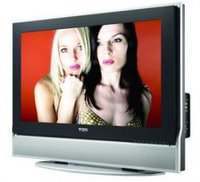Vizio L32 - LCD TV
 Barely sneaking in under the $1,000 price point, the 32-inch Vizio L32 ($999.99 list) is one of the least expensive LCD TVs currently offering high-definition resolution in an attractive, stylish design. The L32's bright and even picture isn't without some minor flaws, but it represents a good value for a relatively inexpensive flat-panel TV.
Barely sneaking in under the $1,000 price point, the 32-inch Vizio L32 ($999.99 list) is one of the least expensive LCD TVs currently offering high-definition resolution in an attractive, stylish design. The L32's bright and even picture isn't without some minor flaws, but it represents a good value for a relatively inexpensive flat-panel TV.The L32 comes with a good selection of A/V connections for an HD monitor at this price. Centered on the rear of the display are one HDMI input, two component video inputs, as well as a VGA input for use with PCs. S-Video and composite video inputs located on the right side of the TV are easily accessible from the front. Nonremovable speakers positioned below the display yielded decent sound quality with no noticeable distortions. The L32's on-display controls were concealed under the lower-right edge of the TV's dark-gray bezel (just above the speaker housing) yet were easy to access and operate. The L32's comfortably rounded, slightly hourglass-shaped remote was easy to operate with one hand. The remote isn't equipped with a backlight or glowing keys, but the buttons are clearly labeled, and direct input selection is available for most A/V connections.
The L32's 31.5-inch panel (measured diagonally) offers a native resolution of 1,366 by 768 pixels (16:9 aspect ratio). PC input was limited to 1,280 by 720 pixels when using the TV's HDMI input, and VGA input came closest to the native resolution with 1,360 by 768 pixels. In addition to supporting a slightly higher resolution, use of the VGA input eliminated overscan (extension of the picture beyond the active portion of the screen). But although the L32 showed minimal overscan with other inputs, it was not flawless: Compared with the L32, the Westinghouse LTV-32w1 exhibited no overscan with 720p video or PC connections when using component, DVI, or VGA inputs. We're nitpicking, but an HD display should fill the screen properly when given HD-resolution imagery and not extend it (even slightly) beyond the edges of the screen.
An unfortunate similarity that the L32 shares with the Westinghouse LTV-32w1 is poor component video when compared with digital video input. Our subjective examinations using DVD videos, Windows Media Video HD clips, and over-the-air HDTV revealed that the L32 was sacrificing dark detail and adding a slight green tinge to skin tones. Switching to the L32's HDMI input significantly reduced these issues. Attempting to correct these component video concerns revealed poorly designed on-screen menus. Although the menus are easy to navigate, they are poorly placed in the middle of the screen, making it difficult to visualize the effect that picture adjustments have on overall image quality. Not since the Optoma RD50A have we seen a TV that failed to minimize the selected adjustment to the bottom (or top) of the screen. We hope we never see such an obstructing menu layout again.
In the lab, the L32's "Vivid2" picture mode registered very good primary color accuracy but showed more variance that we like to see in grayscale tracking (color measurements of stepped levels from black to white.) During testing, we observed that skin tones in dark scenes looked too red, and the tracking measurement confirmed this observation.
We use the HQV Benchmark DVD to gauge a television's video-processing capabilities. This DVD contains a challenging array of synthetic and real-world video tests designed to evaluate how well a television handles common video-related tasks such as deinterlacing, noise reduction, and detail preservation. The L32 scored lowest among the 32-inch LCD TVs we have seen to date. The flag-waving video portion of the test revealed some jagged-edge artifacts, and noise reduction was practically nonexistent. In addition, the L32 was slow to engage 3:2 pulldown for film-based video (24 frames per second), producing visible moiré artifacts in the grandstands of the racetrack clip as well as loss of detail until it properly engaged. The panning shot of the bird statue in the Gladiator DVD (chapter 12) also highlighted this issue, since flickering edges and other artifacts detracted from the viewing experience. As with most consumer televisions, the L32 would benefit from being paired with a decent DVD player that performs proper pulldown to ensure the best picture quality.
The Vizio L32 offers high-definition resolution at an affordable price. Though we were disappointed by the TV's component video quality when compared with digital video input, this is an all-too-common trait among the value-priced HD monitors we have seen. For digital video enjoyment, the L32 is a strong performer with good color accuracy and picture detail. But if component video is equally important to you, the Proview RX-326 is a more consistent performer.
[via: pcmag.com]





